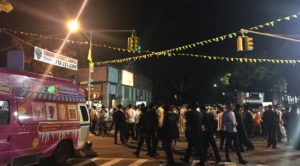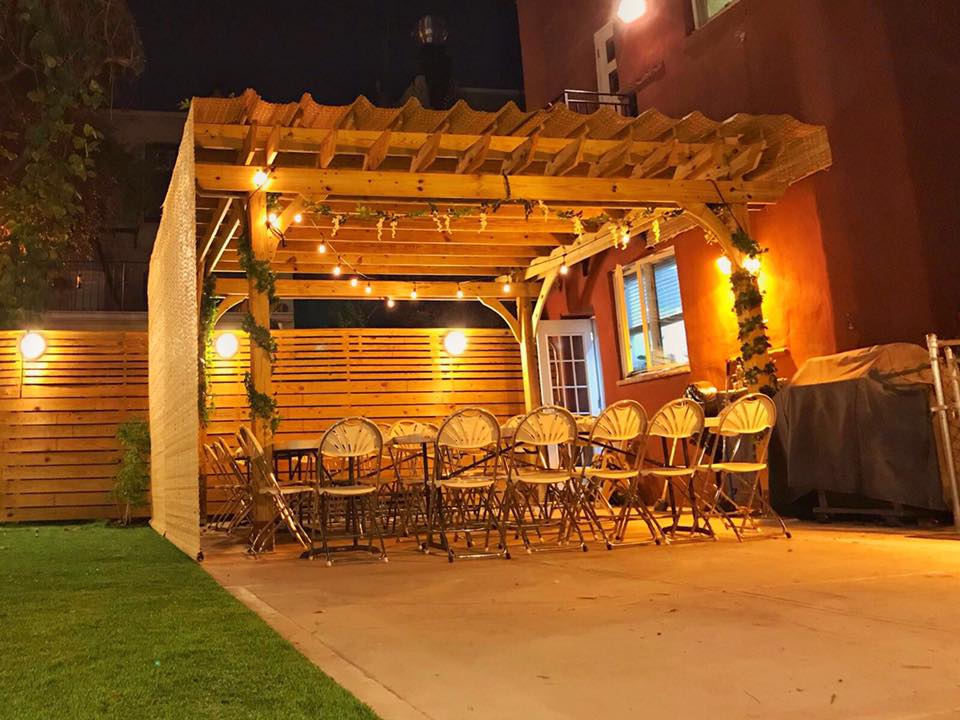At 8pm on the 10th of October, about 20 young Jewish professionals board a school bus in Crown Heights. As they set off into the night, past blocks of brownstones, someone shouts out, “We need some tunes!”. Rabbi Ahrele Loschak, 32, smiles in agreement, and begins to stream Israeli techno music through the bus’s speakers. There’s beers, and good cheer. It is, after all, a holiday—Sukkot or the Feast of Ingathering—when a week of joy and happiness is literally mandated by the Book of Leviticus.

While Sukkot has deeply historic origins, young New Yorkers across the city are reimagining the holiday. This year, Loschak, from the Chabad Young Professionals of Brooklyn, organized an inaugural, boozy ‘sukkah crawl’ across the Borough. It replicates the tradition of visiting different sukkahs (makeshift huts constructed for the week of the feast) in one’s own neighborhood. He says he wanted to take the tradition “up a notch,” and mix it up by curating a “more sophisticated sukkah hop” for participants.
The sukkah crawl is one of many events happening throughout the city that cater to a younger crowd. The night before, there had been a ‘Sukktoberfest,’ and a rooftop Sukkot party organized by the Town & Village Synagogue strictly for young adults only. “You must be between the ages of 21 – 39; please bring an ID,” the details for the event read on Facebook. Elad Kels, a participant in the sukkah crawl who went to Sukktoberfest, said they’re largely events for single Jews.
Unlike the other parties, which were based at one location, the sukkah crawl is mobile, stopping at homes that Rabbi Loshak lined up for the bus. At the first stop, a Crown Heights brownstone, the crowd is welcomed through a family home into a large hut set up on a backdoor patio. In the center of the sukkah; a table dotted with flower arrangements, cakes, chocolate, chips, grapes, vegetables, and cookies. But, the bus isn’t only here to snack. Cocktails, vodka, whisky, beer, and more are also on hand.

Sukkot has a dual purpose: to commemorate both the end of the traditional harvesting and agricultural season as well as the story of the Exodus of the Israelites from Egypt. Building and using a hut harks back to the outdoor shelters farmers used during the harvest, and the transitory experience of the Israelites as they wandered the desert for forty years.
As a result, the huts must be constructed under an open sky (sukkahs under tree cover are not allowed), and the each hut’s roof must be covered with unrefined vegetable matter, like bamboo or palm branches. During the week-long celebration, people are meant to spend as much time as possible and eat all meals in their huts. In some Jewish denominations it is also compulsory to sleep in one’s sukkah.
Hadar Hoffman, 32, says although she is no longer a practising Jew, she came on the sukkah crawl as she was nostalgic for the holiday (which she participated in until her early-twenties) and because of pressure from her parents to partake in Jewish traditions. As a child, she went sukkah hopping and that she used to get excited about candy with her friends. “Now as an adult, I look forward to vegetables,” she says, as she reaches for some carrot and celery sticks. Another participant, Jeremy Meller says he came along because there is “no young professional Jewish scene at all in Long Island,” where he is from.
Sukkot is also a “holiday of inclusion” Rabbi Loshak says, as the tour group stops off at a rooftop sukkah in Park Slope and another in a Clinton Hill garden, it is ushered in by attentive hosts. Loshak says that this spirit of inclusiveness is woven into the very anatomy of the sukkahs themselves as they’re designed to “embrace” people who spend time inside them.
Certainly, the simple, temporary huts level socio-economic disparities because they remove signifiers of wealth (or a lack thereof) usually found in a home. But, Sukkot is not a panacea for all differences—a black woman on the sukkah crawl says she usually has to explain that she is Jewish before she practices the holiday’s traditions with strangers.

The crawl’s final destination is Mendel and Sara Pinson’s brownstone home back in Crown Heights. Their large sukkah is on a wooden deck in the backyard. A live band plays in the garden, and the sukkah crawlers excitedly file in. Throughout the night, the Pinson’s four children pop in and out after visiting friends and wandering through Sukkot celebrations on Kingston Avenue. Sara says that this sums up the holiday, “they are very tired,” she laughs.
After being plied with sushi, Chinese food and more alcohol at the Pinson’s home, so to are the sukkah crawl’s participants. At around midnight, while some go on to more revelry, most head home.
Header photo courtesy of Rabbi Ari Chaya Kirschenbaum.


Leave a Reply